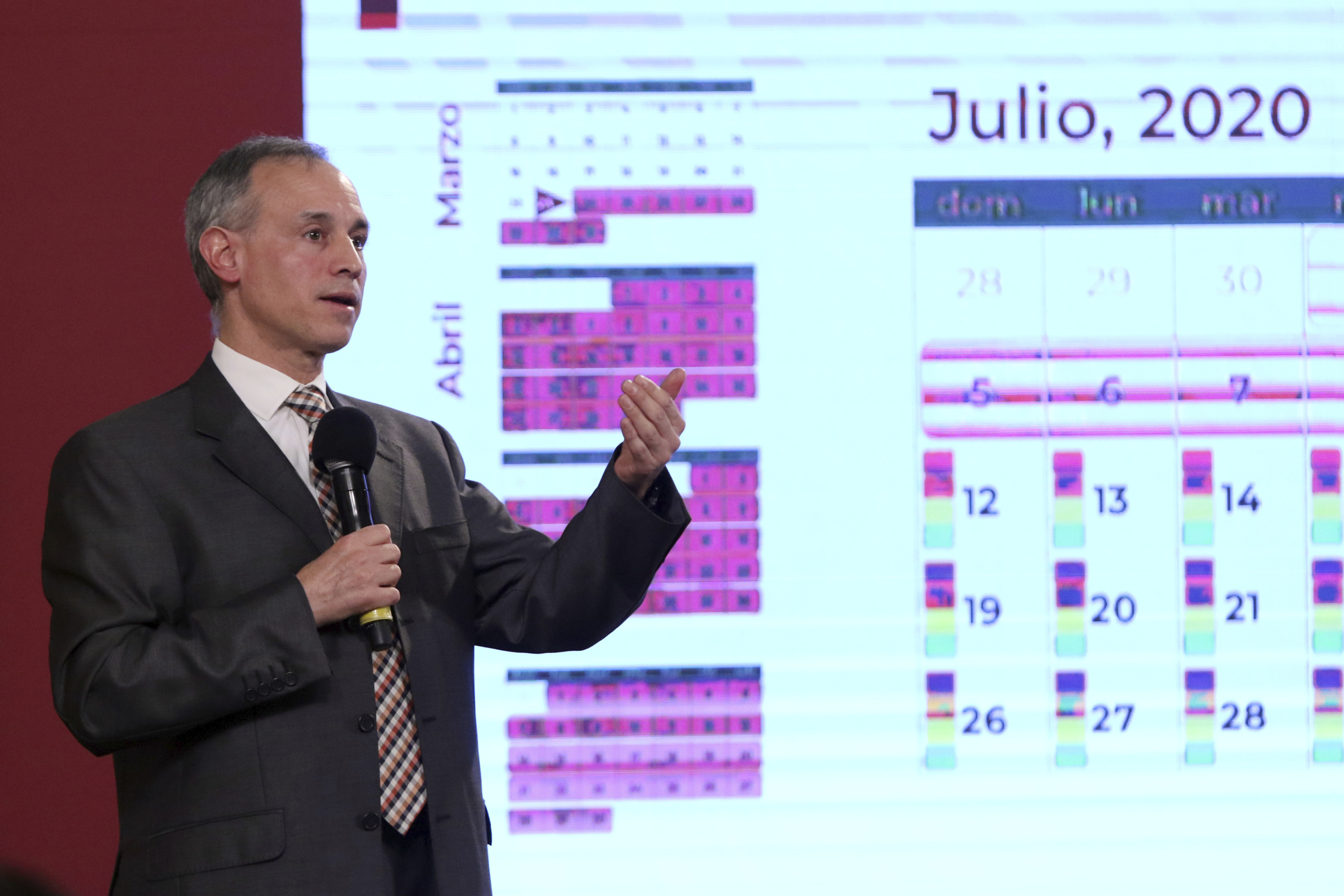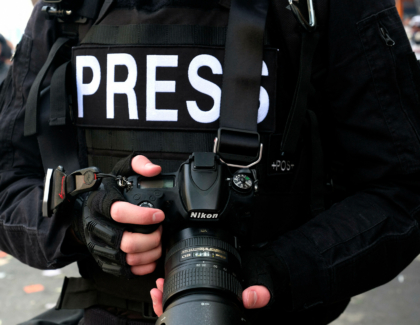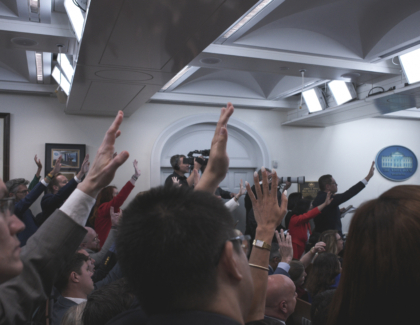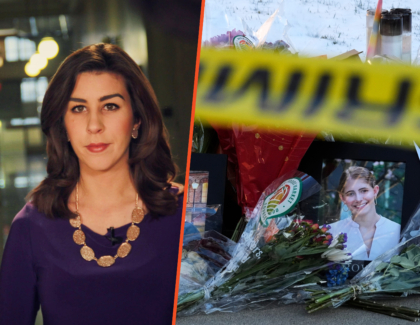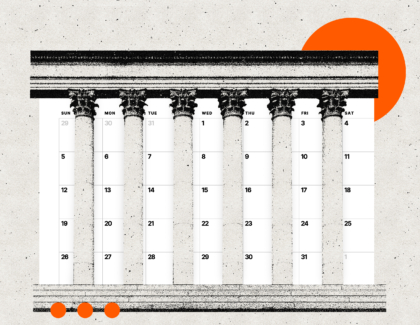Sign up for the daily CJR newsletter.
On March 6, the Mexican Health Ministry began to broadcast daily press briefings on covid-19, the disease caused by the coronavirus. Initially, the audience for the briefings was mostly journalists, but soon the broader populace began to tune in each night at 7pm. Mexicans joke that the briefings have become the new hit telenovela, with Hugo Lopez-Gatell, the ministry’s silver-haired undersecretary of Prevention and Health Promotion, an unlikely heartthrob. Each briefing begins with a PowerPoint presentation of the day’s confirmed deaths and new cases, active and recovered, in Mexico and worldwide. During the early weeks of the pandemic, Mexican social media was frequently flooded with graphs-and-stats-heavy memes that lauded Lopez-Gatell’s presentations.
Such briefings are at the center of the Mexican government’s covid-19 media strategy. They follow a similar tack to the one President Andrés Manuel López Obrador has taken since assuming office in late 2018: incessant information as a stand-in for transparency. But amid the steady stream of information, accurate data remains elusive. Multiple investigations have shown that official counts of confirmed cases and deaths don’t capture the magnitude of the virus’s spread in Mexico. Mexico has a record-low testing rate—at 2.54 tests per confirmed case, the lowest among the thirty-seven countries in the Organisation for Economic Co-operation and Development. Lopez-Gatell has repeatedly acknowledged that the official numbers are likely lower than the actual figures. In a situation already rife with misinformation, including concerns that the government is either neglecting or manufacturing the crisis, such imprecision only fosters more uncertainty. As the country begins reopening, the lack of data transparency poses an information crisis for journalists as well as the general public. And despite journalists’ urgings, officials refuse to take a new tack.
On May 8, the New York Times, the Wall Street Journal, and El País published articles suggesting that the government’s official death toll numbered far fewer than the actual count. In response to those stories, hundreds of pro-AMLO Twitter accounts excoriated the journalists behind them. Health authorities didn’t deny the allegations; rather, in a wordy six-minute response video heavy on epidemiological jargon, Lopez-Gatell discussed the complexities of tracking the numbers.
Shortly thereafter, the think tank Mexicanos Contra la Corrupción y Impunidad (Mexicans Against Corruption and Impunity) released an investigation of death certificates in Mexico City, which showed that deaths attributed to covid added up to three times the cases included in the official count. An investigation by Quinto Elemento Lab in Mexico City showed that 911 calls reporting covid deaths also numbered triple the official count of non-hospital covid deaths. Journalists have reported uncounted deaths and test backlogs across the country.
THE MEDIA TODAY: Trump, Fauci, and the conditions of anonymity
Pablo Pérez, a journalist with Verificovid, a project of the fact-checking initiative Verificado dedicated to fact-checking media claims and social media rumors, points out that federal statistics also differ from those offered at the state level. “Mainstream outlets use the number that works for their editorial line,” he says. “Sometimes they get it from the states, sometimes nationally; there’s a lot of confusion.” Official explanations refer to the criteria for data-gathering on covid deaths: the official deaths count includes only confirmed covid cases, not the many suspected cases that aren’t tested after people die. Lopez-Gatell has affirmed that the data underestimates the actual numbers, but he insists it accurately captures the trends.
Andrea Cárdenas, one of the reporters behind the Quinto Elemento Lab investigation, believes the government is dramatically undervaluing the importance of maintaining official numbers. “We all have the right to know the real number of covid deaths, confirmed, those who didn’t get a test, either because they didn’t go to the hospital or because they were rejected by hospitals,” she says. “Beyond a statistic, the official number of deaths, all those deaths deserve to be counted because those deaths correspond to a person that had dreams, a story, a life, a community. It’s the life of a person—how can that not matter?”
Those numbers also have broader implications for public health. They can explain, Cárdenas says, what populations are turned away from hospitals, as well as who might avoid hospitals altogether, and who fears the widespread stigma around being diagnosed with covid—all issues relevant for journalists, government institutions, and the public in general.
“If the strategy is to control the narrative, it’s going really badly,” says Pérez of available public health information to date. “There are contradicting discourses. Neither the media nor the government are dictating the narrative. Social media is imposing the discourse.” Many Mexicans continue to believe the virus doesn’t exist. The country has begun reopening on a stoplight system; seventeen states are in the orange, or high-risk, phase. But despite admonitions from Lopez-Gatell that the pandemic continues, movement has dramatically increased across the country.
Concern over the quality of public health data stems partially from a historic generalized mistrust of the Mexican state. As of 2019, 87 percent of Mexicans saw the government as deeply corrupt. In a country where prominent media outlets are infamous for receiving money in exchange for parroting official lines, distrust of the media and the state go hand in hand.
Discontent with the government’s handling of the pandemic also has partisan roots. Opponents of President López Obrador, whose antiestablishment rhetoric has won him vehement opposition, take the government’s handling of the pandemic as a referendum on the ruling party. Conversely, the president’s supporters have led social media rampages against journalists who have questioned the government’s data. After the May 8 investigations came out, Twitter was flooded with a bot campaign under the hashtag #PrensaProstituida, or Prostituted Press, against the reporters behind the stories.
Of course, there’s no guarantee that accurate data would make the general public more cautious. “If they say a million, two million [cases], people think that maybe that should scare the public,” Pérez, of Verificovid, points out. “In the case of the US, where they have the most cases, people want to go out anyway.”
The lack of data transparency also poses a challenge for journalists in stretched newsrooms. For journalists without backgrounds in statistics or epidemiology, it’s difficult to critique what one can’t see.
“The government is communicating a complicated set of info to reporters who may or may not be prepared or have the tools to decipher that info,” says Jan Albert Hootsen, the Mexico representative of the Committee to Protect Journalists. “It’s very difficult for beat reporters to communicate what’s going on and make sense of it under all this stress and pressure and polarization.”
“We can’t see public contracts, we can’t see everything that’s being spent, so we have to trust the information that they give us.”
In May, Sarahi Uribe, a reporter for El Sol de México, cited a comment by a former health secretary and then asked Lopez-Gatell whether he was “lying to Mexico” about coronavirus numbers. When the undersecretary asked for clarification, Uribe faltered: “He says there’s… that your data doesn’t add up… let me see.” Lopez-Gatell laughed in response and encouraged the young reporter to investigate and ask the question again later. On social media, users pointed to Uribe’s slip-up as an example of uninformed, ideologically motivated anti-government journalism.
But Uribe’s question indicates the challenge many journalists find themselves facing. Part of the reporter’s job is to interrogate the state’s narrative. When the basis of the narrative is data that only the government has, it’s difficult to find a way in.
In addition to the lack of transparency around cases and deaths, the pandemic has made other public information less accessible.
“The information is concentrated in the federal and local health ministries, so it’s hard to compare it with other sources,” says Cárdenas of Quinto Elemento Lab. “Many offices have prolonged the reopening of their activities, and they don’t answer our information requests. We can’t see public contracts, we can’t see everything that’s being spent, so we have to trust the information that they give us.”
López Obrador has continued to insist that journalism critical of the administration is ideologically motivated. In late April, the president said in a press conference that Mexico lacked a “professional, independent” news media.
“It’s a gross lack of recognition of hundreds of highly professional and independently minded reporters,” Hootsen says. Daily, the country’s reporters “risk their lives, health, reputation, and livelihood even to get the most simple stories out that might be critical.” Mexico continues to be one of the most dangerous countries in the world for journalists. Since the covid-19 lockdown began, two Mexican journalists—Jorge Miguel Armenta Ramos and Maria Elena Ferral—have been murdered. Thirteen have died of covid-19.
Lopez-Gatell continues to show his own frustration with media coverage of the covid crisis. In a late-June press briefing, the subsecretary presented a video he called “The Long Epidemic.” The nine-minute montage showed clips of Lopez-Gatell repeating ad nauseam, from March to June, “We have to be prepared for a long epidemic.”
“Let’s not assume that the journalists or editors or heads or owners of these outlets, who probably finally define the agendas of those outlets, have bad intentions,” Lopez-Gatell concluded. “Maybe they don’t watch the daily press briefing.”
NEW: How election reporters see us, and how we view them
Has America ever needed a media defender more than now? Help us by joining CJR today.



